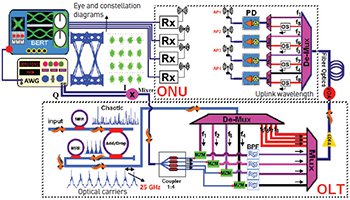 System setup. AP, access point; AWG, arbitrary waveform generator; BERT, bit-error-rate tester; BPF, band-pass filter; MRR, microring resonator; OLT, optical line terminal; ONU, optical network unit; OS, optical splitter; PD, photodiode; Rx, receiver.
System setup. AP, access point; AWG, arbitrary waveform generator; BERT, bit-error-rate tester; BPF, band-pass filter; MRR, microring resonator; OLT, optical line terminal; ONU, optical network unit; OS, optical splitter; PD, photodiode; Rx, receiver.
In an era of increasing demand for bandwidth, wavelength division multiplexed passive optical networks (WDM-PONs) integrated with radio-over-fiber (ROF) offer a potentially attractive way to deliver wired and wireless services simultaneously. Making this work, however, will require a way to increase the number of WDM-PON access points (APs). Optical multicarriers generated by microring resonators (MRRs) can be used in WDM-PON-ROF for transmitting orthogonal frequency division multiplexing (OFDM) signals. We have recently developed new techniques using MRRs for generating optical soliton carriers used in integrated optics and photonics.1–3
Our work is shown schematically in the accompanying figure. MRRs at the optical line terminal (OLT) generate eight optical carriers with free spectral range of 25 GHz. An OFDM scheme is used to achieve high spectral efficiency and better transmission performance. For four of these carriers (f1 to f4), Mach-Zehnder modulators are used to modulate 43.6 Gb/s OFDM for downlink, to provide wired and wireless connections. The other four carriers (f5 to f8) remain unmodulated, for use in generating a 110-GHz OFDM signal. (An arbitrary waveform generator creates the OFDM signals.)
At the optical network unit (ONU) section, a demultiplexer receives a beam consisting of multiple optical frequencies from a fiber. The first channel has been multiplexed with the unmodulated wavelength f5, which had a 100-GHz difference; the second channel has been multiplexed with f6, and so on. Accordingly, there are four APs (AP1 to AP4), in which high-speed photodiodes (PDs) are used to generate four electrical 110-GHz millimeter wave signals for wireless propagation. A dielectric resonator array antenna is used to transmit and receive W-band signals. At the receiver side, the propagated W-band signal is received by the OFDM receiver and is demodulated and detected using a local oscillator with W-band frequency.
The eye diagram and constellation diagram inset into the figure show system performance for AP1 servicing, when the wireless distance is 2 m and the optical link is 25 km. These results show that it is possible to use MRR to generate multicarriers with suitability for WDM-PONROF applications.
Researchers
I.S. Amiri and H. Ahmad, University of Malaya, Kuala Lumpur, Malaysia
S. Alavi, Universiti Teknologi Malaysia, Johor Bahru, Johor, Malaysia
References
1. I.S. Amiri et al. IEEE J. Quantum Electron. 50, 622 (2014).
2. M. Soltanian et al. Laser Phys. Lett. 12, 065105 (2015).
3. I.S. Amiri et al. Sci. Rep. 5, 11897 (2015).
